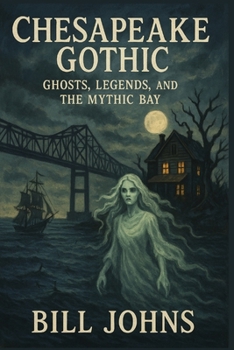Chesapeake Gothic: Ghosts, Legends, and the Mythic Bay
Ghost stories are not just tales. On the Chesapeake Bay, they are maps of what was lost. They mark submerged towns, erased names, vanished labor, and grief that never received a headstone. Chesapeake Gothic: Ghosts, Legends, and the Mythic Bay is a folkloric, historical, and deeply personal journey into one of America's most haunted-and haunting-landscapes. From the drowned bells of Holland Island to the spectral lights still seen flickering near abandoned lighthouses, this book travels through marshes, ferry crossings, graveyards, and vanished plantations, gathering stories where the land itself is slipping away. Across twenty-three chapters, folklorist and writer Bill Johns listens to the stories that cling to the Bay's receding edges-stories told in silence, in wind, in water, in the things that no longer have names. Ghost stories are not distractions here. They are the record. They are how the Bay remembers when history fails. Unlike conventional collections of regional lore, Chesapeake Gothic treats these stories not as curiosities, but as cultural documents-evidence of trauma, displacement, and historical absence. The haunted lighthouse isn't just a place of fright; it's a marker of maritime solitude and vanished labor. The weeping woman along the shoreline speaks to gendered loss and erased domestic histories. The Black dog, the Black man, and the Black water-themes that recur in hushed tones and nighttime warnings-reveal the racial hauntings of a region shaped by slavery, segregation, and silence. These are not simply legends. They are grievances, questions, and warnings passed down when nothing else was allowed to remain. The book is grounded in the author's own lifelong relationship with the Bay. From childhood weekends exploring by boat with his father-visiting islands that no longer exist, swimming to abandoned lighthouses overtaken by bees, discovering half-feral goats where towns once stood-Johns draws on memory as both archive and argument. What he learned in the tide, he later came to understand in story: that haunting is a way the Bay speaks when no one else will listen. With chapters on drowned churches, phantom ferry crossings, screaming marshes, and haunted cartographies, Chesapeake Gothic is at once a folkloric field guide, an elegy for lost communities, and a meditation on what it means to inherit a landscape that is always disappearing. Drawing from WPA folklore archives, oral histories, environmental studies, and local legend, the book offers readers a new way to engage with folklore-not as something to be believed or debunked, but as a form of memory that persists when other records fail. This is a book for readers who understand that the supernatural is often where the suppressed becomes visible. That folklore is not fiction, but fidelity. That ghosts are not just revenants-they are the voices of those denied a place in the archive. Whether you're a scholar of regional history, a lover of spectral tales, or someone who has stood on a quiet dock at night and felt the air shift, this book invites you into the layered geography of the Bay's past. Because the land does not forget. The water never does. And in the Chesapeake, some stories do not rest. They rise. Shoppers searching for Chesapeake Bay folklore, ghost stories of Maryland and Virginia, haunted maritime legends, drowned towns, or Southern Gothic non-fiction will find this book rich in story and resonance. Written in the tradition of regional studies like Ghostland, American Ghost, and The Unquiet Grave, it also stands as a literary heir to the Chesapeake's own gothic imagination-a map of absence, a record of return, and an invitation to listen to the stories the tide still tells.
Format:Paperback
Language:English
ISBN:B0FBMCWFZB
ISBN13:9798286162079
Release Date:June 2025
Publisher:Independently Published
Length:496 Pages
Weight:1.45 lbs.
Dimensions:1.0" x 6.0" x 9.0"
Customer Reviews
0 rating





